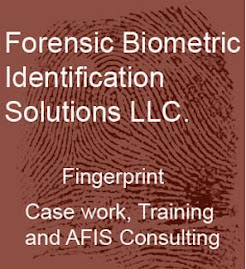The following article brought out a number of good points;
http://www.suburbanchicagonews.com/beaconnews/news/1781113,2_1_AU21_PRINTS_S1-090921.article
"And of course, he wants the assailant caught as soon as possible, which is why the seven-month wait for a fingerprint match has him upset. Police do have a match on the suspect now, he said, but now they're asking his relative to identify someone she hasn't seen in seven months. " A backlog causing a delay like this not only increases the likelihood of additional criminal activity by the criminal but also the possibility of an escalation in the violence in future crimes.
The other point made by this article: "Aurora's crime lab doesn't: an Automated Fingerprint Identification System, or AFIS. According to Leroy Keith, an Aurora alderman who also works as assistant director of DuPage County's crime lab, the equipment itself costs about $50,000. But that's not the big expense: You also need people trained to make the final matches." As indicated in earlier blogs having trained latent fingerprint examiners requires 2 yr's minimum of full time training to become a competent examiner. The expense and time can often tempt smaller agencies to not fully commit to the required training increasing the possibility for error.
While technology continues to improve we should expend similar resources to insure the individuals working with the automated systems are the highly trained individuals required for the systems.
Bob McAuley
Dir. Operations/Training
Forensic Biometric Identification Solutions LLC.
Monday, September 21, 2009
Monday, September 7, 2009
Another Erroneous Fingerprint Identification
Posted an article in a number of places a few days ago from the NY Daily News about a large settlement for an individual incarcerated for 523 days because of an error in a fingerprint comparison. The thing that caught my eye 1st. was the liability cost,which while significant was not exorbitant.
Then I looked at the article again to see the real cause of the error, because unlike the FBI Mayfield error, this was just a robbery and in NYC that is not a high profile case.
So what went right and what went wrong on this fingerprint comparison. What went right was an experienced examiner who was confident enough in his skill sets said " you know what ? this is a screw; this is not his fingerprints." If it were not for this detective the individual in this case would have been convicted and gone to prison. What went wrong ? The original comparison followed the ACE-V individualization model followed by latent examiners, in that you had 2 experienced latent examiners incorrectly identify the individual. The legal aid attorney advised the victim to take a plea agreement that would have been 5 yr's, an indication that the fingerprint evidence was not re-evaluated by the defense.
So what could have been done to prevent this from happening ? As I've stated in previous blogs having fingerprint evidence evaluated by the defense is key to preventing miscarriages of justice. It is really the defense attorney who is responsible to insure the evidence is valid in the adversarial system of justice we have in the United States. I know that resources for expert testimony are limited especially for legal aid but the cost of a fingerprint evaluation should significantly less than expert testimony so it should not cost more than a service call from an electrician. The images can be sent to the expert digitally via Internet or photographs via snail mail for an initial evaluation.
Incorrect fingerprint comparisons do occur and with the automated systems producing many more suspects having strong similarities the numbers of error most likely will continue to increase. The best option currently available is for the defense to have the fingerprints evaluated by an unbiased 3rd. party.
Bob McAuley
Dir. Operations/Training
Forensic Biometric Identification Solutions LLC.
Then I looked at the article again to see the real cause of the error, because unlike the FBI Mayfield error, this was just a robbery and in NYC that is not a high profile case.
So what went right and what went wrong on this fingerprint comparison. What went right was an experienced examiner who was confident enough in his skill sets said " you know what ? this is a screw; this is not his fingerprints." If it were not for this detective the individual in this case would have been convicted and gone to prison. What went wrong ? The original comparison followed the ACE-V individualization model followed by latent examiners, in that you had 2 experienced latent examiners incorrectly identify the individual. The legal aid attorney advised the victim to take a plea agreement that would have been 5 yr's, an indication that the fingerprint evidence was not re-evaluated by the defense.
So what could have been done to prevent this from happening ? As I've stated in previous blogs having fingerprint evidence evaluated by the defense is key to preventing miscarriages of justice. It is really the defense attorney who is responsible to insure the evidence is valid in the adversarial system of justice we have in the United States. I know that resources for expert testimony are limited especially for legal aid but the cost of a fingerprint evaluation should significantly less than expert testimony so it should not cost more than a service call from an electrician. The images can be sent to the expert digitally via Internet or photographs via snail mail for an initial evaluation.
Incorrect fingerprint comparisons do occur and with the automated systems producing many more suspects having strong similarities the numbers of error most likely will continue to increase. The best option currently available is for the defense to have the fingerprints evaluated by an unbiased 3rd. party.
Bob McAuley
Dir. Operations/Training
Forensic Biometric Identification Solutions LLC.
Subscribe to:
Comments (Atom)






